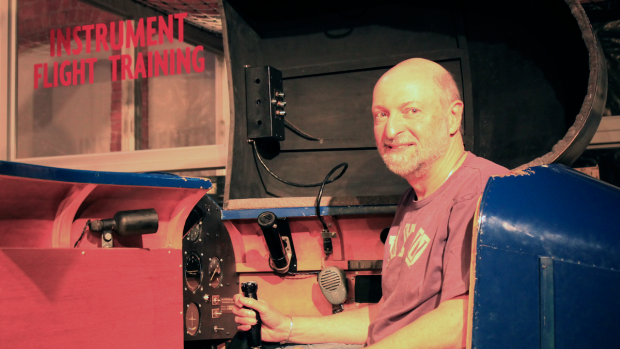Alum Howie Hollander is on a mission to inspire the next generation of scientists and engineers

Alum Howie Hollander sitting in a 1940s era Link Flight Trainer at the Museum of Science and Technology in Syracuse, NY
Enter the gates of the Great New York State Fair, held annually in Syracuse, and there will be countless attractions demanding your attention, from bone-shaking carnival rides to foods stalls offering a wide variety of deep-fried items, and from main-stage musical performances to racing pigs.
Thanks in part to Howie Hollander (’73), fair-goers can also visit a 2,000-square-foot exhibit hall devoted to Science, Technology, Engineering, Arts, and Mathematics — fields collectively known as STEAM. Hollander, who earned a bachelor’s degree in electrical engineering at NYU’s campus in University Heights, volunteers as the Fair exhibit co-chair and organizes the many exhibitors who come to Syracuse each year. Exhibitors demonstrate drones, combine art and physics using a swinging three-pendulum rotary harmonograph made from recycled and repurposed materials, set up giant Jenga-like games that require geometric mastery, and much more. “My biggest goal is to engage kids who aren’t sure what they want to be,” he says. “I had a great career in the aerospace industry, so why wouldn’t I want to spread the word about engineering? We might not get a lot of face time with each child, because they’re focused on collecting swag and getting out to the rides and food, but we can plant a seed of interest with a fun activity.”
Hollander has been active in STEM outreach since moving to Syracuse decades ago. “I’ve always been one to raise my hand and volunteer,” he explains, “and from working in industry I know there is an enormous need to create a pipeline of future professionals.” To that end, in 1995 he joined the board of the Technology Alliance of Central New York (TACNY), a group dedicated to raising community awareness of the importance of technology, encouraging appreciation of it, and boosting educational initiatives. From 2005 to 2014 he served as the organization’s president and is now ensconced as president emeritus. (He recruits many of the fair’s STEAM exhibitors through connections he has made via TACNY.)
If you’re not inclined to think of Syracuse as a hotbed of tech, consider that a Syracuse-based test site is one of only seven nationwide designated by the Federal Aviation Administration to develop ways to safely integrate drones into the national airspace, as well as home to several companies working with radar technology, including Lockheed Martin, where Hollander worked for 29 years. Even Willis Carrier came to Syracuse, the snowiest city in the country, to manufacture air conditioners, as Hollander points out. The city is also home to the popular Museum of Science and Technology (MoST), which has, not surprisingly, counted Hollander as a board member since 2005. (In 2018 he became board chairman.)
The first hands-on science museum in Upstate New York, MoST is now housed in the former Syracuse Armory building and boasts 35,000 square feet of exhibit space, as well as the only domed film IMAX theater in New York State. “I took my own children to the museum in the 1980s and have very fond memories of that period,” he recalls. “I know young people visiting today are making equally good memories, whether they are participating in our Bridge Build ‘Em and Bust ‘Em competition, testing their skills at our rocketry or robotics challenges, catching an educational IMAX film, or visiting our new permanent exhibit on dinosaurs.”
Hollander’s son, Jonathan, who holds a doctoral degree in materials science, concurs. “The museum turned learning about science into a fun and social activity,” he says. “I gained a basic understanding about surface tension from creating bubbles the size of walls [there], and decades later, I applied this concept on a nanoscale while researching atomic adhesion on the surface of semiconductors.”
The museum has also hosted CyberDay4Girls, an event designed to introduce middle-school girls in the vital, in-demand field. “It’s important that we encourage diversity in STEM and inspire participation by groups underrepresented in those fields,” Hollander (who has also served for years as an instructor for skiers with disabilities) asserts. “This can be a rewarding path for everyone.”
That path does not have to end at retirement, as Hollander himself proves. “The world will always need scientists, technologists, and engineers, and I am lucky to have the time and capacity to help in some way,” he says.




